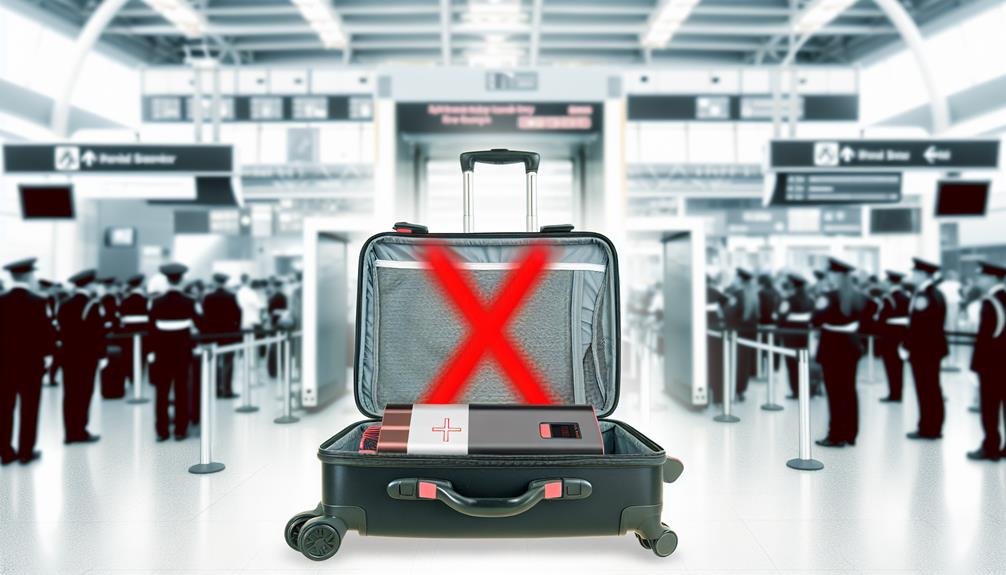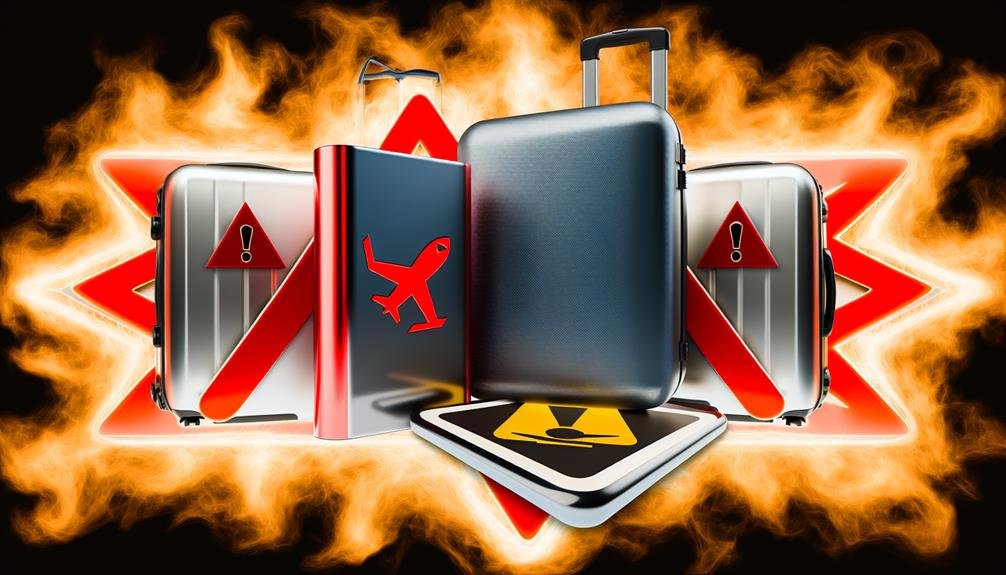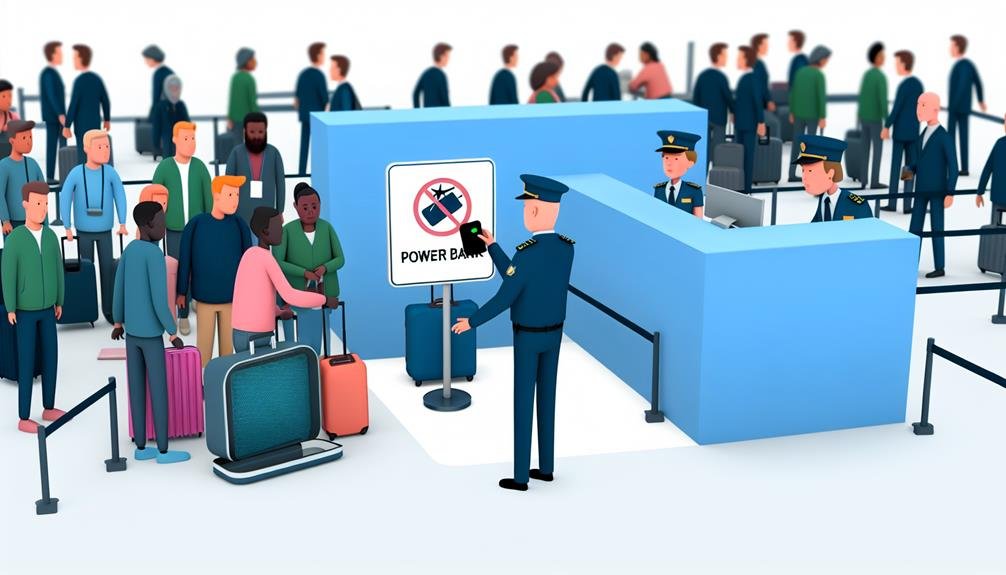No, you can't pack power banks in checked luggage. Airlines and international regulations require power banks to be in carry-on luggage for safety reasons. These batteries can pose a fire hazard and need to be accessible during the flight. Confirm your power bank's watt-hour rating is marked; most airlines allow up to 100Wh without special permission. If your device ranges from 100Wh to 160Wh, you might need airline approval. Power banks over 160Wh are typically banned. Following these guidelines is crucial for a smooth travel experience and upholds flight safety standards. Learn more about how to comply with these regulations.
Airline Regulations

When it comes to airline regulations, you'll find that most carriers strictly prohibit packing power banks in checked luggage due to safety concerns. This prohibition is primarily driven by the potential hazards posed by lithium batteries, which are commonly used in power banks. Lithium batteries can overheat, catch fire, or even explode under certain conditions, making them a significant risk when stored in the cargo hold of an aircraft.
To ensure your journey is smooth and safe, familiarize yourself with the airport restrictions and airline rules regarding travel essentials like power banks. Most airlines mandate that power banks must be carried in your hand luggage. Keeping them in the cabin allows the flight crew to quickly address any issues that might arise, thereby enhancing overall safety.
Moreover, airlines generally have specific guidelines on the maximum capacity of lithium batteries allowed. Typically, power banks with a capacity of up to 100 watt-hours (Wh) are permitted without prior approval, while those between 100 and 160 Wh may require airline consent. It's crucial to check your carrier's specific policies to avoid any last-minute surprises at the airport. By adhering to these airline regulations, you'll contribute to a safer flying experience for everyone.
International Guidelines
When traveling internationally, you must adhere to varying airline security policies and battery capacity limits. These regulations can differ substantially from country to country, so it's essential to check specific guidelines before packing your power bank. Ignoring these rules may result in confiscation or fines, so always stay informed.
Airline Security Policies
In line with international guidelines, it's noteworthy that most airlines prohibit the packing of power banks in checked luggage due to safety concerns related to lithium-ion batteries. These batteries can potentially overheat and cause fires, which is why the rules are so strict. Adhering to TSA guidelines and airline restrictions is essential to guarantee your travel experience is both safe and compliant.
When preparing for your trip, you should be aware of the following key points:
- TSA Guidelines: The Transportation Security Administration (TSA) requires that power banks must be carried in your carry-on luggage. This allows for immediate access and monitoring by security personnel.
- Airline Restrictions: Various airlines may have specific restrictions regarding the watt-hour (Wh) limit of power banks allowed onboard. Always check with your airline before traveling.
- Security Checks: During security checks, you may be asked to remove power banks from your carry-on for separate screening. This ensures they are properly inspected and comply with travel regulations.
Battery Capacity Limits
It is important to be aware that international guidelines dictate specific battery capacity limits for power banks when traveling by air. Generally, power banks with a capacity of up to 100 watt-hours (Wh) are allowed in carry-on luggage without prior approval. However, power banks between 100 and 160 Wh may require airline approval before you can bring them onboard. Power banks exceeding 160 Wh are typically prohibited in both carry-on and checked luggage due to stringent charging restrictions and safety concerns.
When packing your travel essentials, it is vital to verify the watt-hour rating of your power sources. You can calculate the watt-hour rating by multiplying the voltage (V) by the ampere-hour (Ah) rating of the battery. For instance, a 20,000mAh (20Ah) power bank operating at 5V would be 100Wh (20Ah x 5V).
Country-Specific Regulations
Have you pondered how country-specific regulations might impact your ability to bring power banks on international flights? Battery restrictions and travel limitations can vary from country to country, making it important to stay informed before you pack your bags. Here are a few key points to take into account:
- Battery Capacity Limits: Some countries have strict limits on the watt-hour (Wh) rating of lithium-ion batteries. For example, the European Union generally allows batteries up to 100 Wh in carry-on luggage but enforces stricter controls on those exceeding this threshold.
- Airline Policies: Different airlines may have their own rules regarding power banks. While some might permit them in carry-on luggage only, others could have more stringent policies. Always check with your airline before your flight.
- Security Checkpoints: Certain countries mandate thorough inspections of electronic devices at security checkpoints. Inconsistencies in international guidelines mean that what's acceptable in one country might be prohibited in another.
Remaining vigilant about these regulations can help make sure your travel plans proceed smoothly. It's important to verify both the destination country's rules and your airline's policies regarding battery restrictions and travel limitations to avoid unexpected complications.
Safety Concerns

Airlines strictly regulate packing power banks in checked luggage due to potential fire hazards. The primary safety concern here is battery safety. Lithium-ion batteries, which power banks typically use, are prone to overheating and can potentially ignite. This risk is amplified in the cargo hold of an aircraft, where monitoring and immediate response to such incidents are limited. It is crucial to conduct a thorough risk assessment before deciding where to pack your power bank.
When you pack a power bank in checked luggage, it may be subject to extreme temperature fluctuations and physical impacts. These conditions can compromise battery integrity, increasing the likelihood of a dangerous thermal runaway event. Additionally, any damage to the power bank's internal structure can lead to short-circuiting, further heightening the fire risk. You need to consider these factors seriously to ensure your safety and that of your fellow passengers.
Airlines impose these strict regulations to mitigate these risks, emphasizing the importance of battery safety in air travel. By adhering to these guidelines, you're not just complying with rules; you're actively participating in maintaining a safe flying environment for everyone onboard.
Allowed Battery Sizes
Understanding the allowed battery sizes for power banks is pivotal to guarantee compliance with airline regulations and maintain flight safety. Airlines impose specific restrictions on battery capacity to mitigate the risks associated with lithium-ion batteries, which can pose fire hazards. Compliance with these regulations is essential, especially for international travel where rules may vary.
When planning your trip, keep these key points in mind regarding battery sizes:
- Batteries up to 100Wh: Most airlines allow power banks with a capacity up to 100 watt-hours (Wh) in both carry-on and checked luggage without prior approval. This covers the majority of consumer-grade power banks.
- Batteries between 100Wh and 160Wh: You can carry power banks within this range, but they typically require airline approval. These are generally higher-capacity units, often used for professional equipment.
- Batteries over 160Wh: Power banks exceeding 160Wh are usually prohibited in both carry-on and checked luggage due to the increased fire risk they pose.
To ensure a smooth and safe travel experience, always check the specific airline restrictions before packing your power bank. Understanding these guidelines helps you avoid surprises at the airport and guarantees compliance with international travel rules. Remember, staying informed about battery capacity and adhering to airline restrictions is crucial for your safety and that of fellow passengers.
Packing Tips
When packing power banks for your trip, always make sure they're securely placed in your carry-on luggage to comply with airline safety regulations. It's important to prioritize safety by storing power banks in dedicated compartments within your carry-on. This not only keeps them within easy reach but also minimizes the risk of accidental activation or damage.
One essential packing hack involves using a small pouch or case specifically designed for electronics. This helps in organizing your travel essentials and guarantees that your power banks are shielded from potential impacts. Additionally, always check the watt-hour rating of your power banks; most airlines have strict limits. Knowing these limits and adhering to them can prevent any last-minute hassles at the airport.
Luggage organization is key to a smooth travel experience. Place your power banks alongside other essential electronics, such as chargers and cables, to streamline security checks. Avoid overpacking your carry-on, as cramming too many items can lead to damage. Use organization tips like compartmentalizing your bag and labeling items for quick identification.
Alternative Solutions
Evaluating the strict regulations on carrying power banks, examining alternative solutions can ensure both compliance and convenience during your travels. One of the most effective ways to navigate battery pack restrictions is to optimize your use of portable chargers. Here are three key strategies to ponder:
- Invest in Airline-Compliant Power Banks: Look for portable chargers that specifically state they meet airline regulations. Typically, these will have a capacity under 100Wh.
- Prioritize Carry-On Luggage: The safest and most compliant option is to keep your power banks in your carry-on. This avoids potential hazards and aligns with most airlines' rules.
- Utilize Airport Charging Stations: Many airports are equipped with charging stations. Using these can reduce your reliance on carrying multiple power banks.
Real-Life Examples

Many travelers have faced challenges with power bank regulations, devising innovative and compliant solutions to keep their devices charged. One frequent flyer shared their travel experience about a power bank that caused battery issues, triggering alarms at airport security. They had to clarify the battery's specifications and ultimately had to shift it to their carry-on.
Another traveler, more cautious, dodged such issues by researching airline policies in advance. They found out that power banks with a capacity above 100Wh are generally prohibited in checked luggage. This proactive approach guaranteed they passed through security smoothly.
| Traveler | Issue Encountered | Solution Implemented |
|---|---|---|
| Frequent Flyer | Battery issues at security | Moved to carry-on |
| Cautious Planner | Avoided by research | Checked airline policies |
| Business Traveler | Unaware of rules | Power bank confiscated |
| Tech Enthusiast | High-capacity power bank | Used multiple smaller banks |
A business traveler, oblivious to the restrictions, had their power bank confiscated by airport security, leading to a stressful situation. In contrast, a tech enthusiast who frequently carries high-capacity power banks found it safer to travel with multiple smaller ones instead.
These real-life examples underscore the significance of comprehending power bank regulations to evade battery issues and guarantee a smooth passage through airport security.
Final Tips
When packing power banks in checked luggage, you'll need to follow safe packing practices and be aware of airline regulations. Make sure your power bank is securely placed in your luggage to prevent damage or potential hazards. Always check with your airline for specific rules to avoid any travel disruptions.
Safe Packing Practices
Always ensure your power bank is securely wrapped in non-conductive material to prevent any accidental short-circuits during transit. This step is essential for proper storage and safety. Power banks can pose a notable risk if not handled correctly, potentially impacting other electronics in your luggage.
Follow these safe packing practices:
- Use a protective case: Always store your power bank in a dedicated, hard-shell case designed to withstand impacts and prevent damage.
- Keep away from metals: Avoid placing the power bank near metal objects like keys or coins, which could cause a short-circuit.
- Avoid extreme temperatures: Never expose your power bank to high heat or freezing conditions, as these can degrade its performance and safety.
Being vigilant about how you store your power bank can considerably reduce the risk of accidents. Make sure the power bank is turned off before packing it, and double-check that it's not in contact with any sharp objects that could pierce the battery. Remember, the impact on electronics can be severe if a power bank malfunctions.
Airline Regulations
Before heading to the airport, familiarize yourself with airline regulations concerning power banks to guarantee compliance and avoid potential issues during your journey. Power banks, due to their lithium-ion batteries, are subject to specific travel restrictions aimed at ensuring battery safety. Most airlines prohibit power banks in checked baggage because of the fire risk associated with lithium-ion batteries. Instead, they must be carried in your carry-on luggage.
Check your airline's specific rules as they can vary. Typically, power banks with a capacity of up to 100 watt-hours (Wh) are allowed in carry-on baggage without prior approval. For those between 100 Wh and 160 Wh, you may need the airline's permission. Power banks exceeding 160 Wh are generally prohibited.
Ensure that your power bank is clearly marked with its watt-hour rating. If it's not, calculate it by multiplying the voltage (V) by the ampere-hours (Ah). Always pack your power bank in a protective case to prevent short circuits and damage. Remember, spare batteries should also follow these guidelines.
Frequently Asked Questions
Can Multiple Power Banks Be Carried in Hand Luggage?
Wondering if you can carry multiple power banks in hand luggage? Safety considerations and airline regulations dictate yes, but make sure battery capacity meets guidelines. Charging options must be safe to avoid hazards. Always check specific airline policies.
Are There Specific Brands of Power Banks Recommended for Air Travel?
When considering recommended brands for air travel, opt for those compliant with TSA regulations. Brands like Anker and RAVPower are trusted. Always check watt-hour limits and confirm your power bank's within the airline's allowed specifications.
How Do I Check the Watt-Hour Rating of My Power Bank?
To check your power bank's watt-hour rating, locate the label or manual, then calculate by multiplying voltage (V) by amp-hours (Ah). Verify it meets airline regulations for measuring capacity to avoid safety issues during travel.
What Should I Do if My Power Bank Is Damaged During a Flight?
Imagine a storm in your pocket. If your power bank's damaged during a flight, prioritize power bank safety by reporting it immediately to airline staff. Familiarize yourself with airline regulations to guarantee proper handling and replacement.
Can I Use My Power Bank While on the Plane?
Yes, you can use your power bank on the plane, but follow charging etiquette. Confirm your device is in airplane mode to avoid interference. Always check the airline's regulations, as some restrict in-flight power bank usage for safety.



